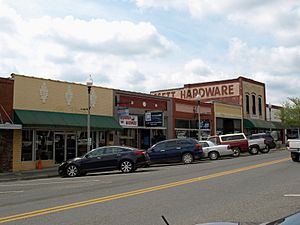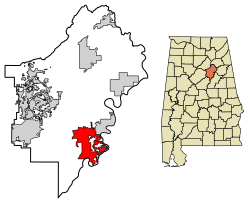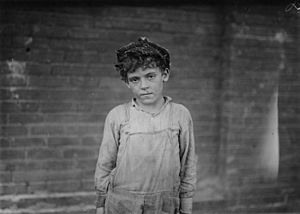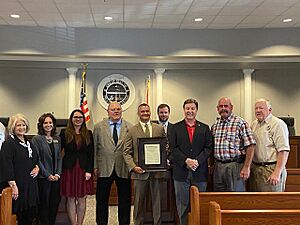Pell City, Alabama facts for kids
Quick facts for kids
Pell City, Alabama
|
||
|---|---|---|

Buildings in historic district
|
||
|
||

Location of Pell City in St. Clair County, Alabama.
|
||
| Country | United States | |
| State | Alabama | |
| County | St. Clair | |
| Government | ||
| • Type | Council-manager government | |
| Area | ||
| • Total | 27.76 sq mi (71.90 km2) | |
| • Land | 25.00 sq mi (64.75 km2) | |
| • Water | 2.76 sq mi (7.14 km2) | |
| Elevation | 597 ft (182 m) | |
| Population
(2020)
|
||
| • Total | 12,939 | |
| • Density | 517.54/sq mi (199.82/km2) | |
| Time zone | UTC-6 (Central (CST)) | |
| • Summer (DST) | UTC-5 (CDT) | |
| ZIP codes |
35125, 35128, 35054
|
|
| Area code(s) | 205, 659 | |
| FIPS code | 01-58896 | |
| GNIS feature ID | 0164801 | |
| Website | http://pell-city.com/ | |
Pell City is a city in Alabama, United States. It is one of the two main government centers, called county seats, for St. Clair County, Alabama. The other county seat is Ashville. In 2020, about 12,939 people lived in Pell City.
Pell City was once home to a large textile factory called Avondale Mills. This factory was a very important part of the city's history and growth.
Contents
History of Pell City
How Pell City Started
Pell City was founded in 1890 by people who invested in railroads. They named the city after George Pell, who was a financial supporter of the Pell City Iron and Land Company. The city officially became a city on May 6, 1891. However, it faced difficulties during a financial crisis in 1893.
The Avondale Mills Era
The city got a new start in 1902 when Sumter Cogswell built the Pell City Manufacturing Company. This company later became Avondale Mills. It was a huge part of the town's economy and social life for many years.

Besides the textile mill, farming and local shops also helped the economy. Large farms grew cotton and soybeans, and raised cattle. In 1956, Pell City grew bigger by joining with the nearby towns of Eden and Oak Ridge. Green Evans was the city's first mayor.
The homes of Sumter Cogswell and Green Evans are some of the oldest buildings in the city. Most of the historic buildings were built between 1902 and 1905.
Two County Seats
For a long time, Ashville, Alabama was the only county seat for St. Clair County. But in 1907, Pell City also became a county seat. This made St. Clair County unique because it had two full-service county seats. Both still operate today. Pell City has grown much faster than Ashville, partly because of I-20 and Logan Martin Lake.
Logan Martin Lake and Growth
The building of Logan Martin Dam in 1964 created Logan Martin Lake. This lake became a popular spot for recreation. It brought new businesses, tourists, and many new residents who built homes along the lake.
Important Events
In April 1998, a strong windstorm, like a tornado, hit north of the city. It caused damage to a church, many homes, and other buildings. Several people were injured. A church in Odenville was destroyed shortly after its members left a practice because of the storm.
In 2006, Avondale Mills stopped working. Then, in February 2008, the old Avondale Mills building caught fire by accident. No one was hurt in the fire. The company that owned the building was already taking it apart for materials. The water tower from the mill still stands, but the smokestack was later taken down because it was unsafe.

In 2015, a video of the Avondale Mills smokestack demolition became very popular online. During the demolition, the old structure fell on a construction worker, Tim Philfer. Luckily, he was not hurt.
Geography
Pell City covers about 27.2 square miles (70.4 square kilometers). About 2.6 square miles (6.7 square kilometers) of this area is water, mostly from Logan Martin Lake. It is the largest city in St. Clair County.
Logan Martin Lake
The city is located on the shores of Logan Martin Lake. This lake was created in 1964 when Logan Martin Dam was built. The dam helps produce electricity for the central part of Alabama.
Roads and Nearby Areas
Pell City is located along Interstate 20. This highway runs through the northern part of the city. It goes east to Atlanta and west to Birmingham. You can get to Pell City from exits 156 and 158 on I-20.
U.S. Route 231 also passes through the city. It goes north to Ashville and southwest to Harpersville. U.S. Route 78 also runs through Pell City, following I-20.
Population Information
| Historical population | |||
|---|---|---|---|
| Census | Pop. | %± | |
| 1900 | 98 | — | |
| 1910 | 530 | 440.8% | |
| 1920 | 825 | 55.7% | |
| 1930 | 835 | 1.2% | |
| 1940 | 900 | 7.8% | |
| 1950 | 1,189 | 32.1% | |
| 1960 | 4,165 | 250.3% | |
| 1970 | 5,602 | 34.5% | |
| 1980 | 6,616 | 18.1% | |
| 1990 | 8,118 | 22.7% | |
| 2000 | 9,565 | 17.8% | |
| 2010 | 12,695 | 32.7% | |
| 2020 | 12,939 | 1.9% | |
| U.S. Decennial Census | |||
2020 Census Details
| Race | Number | Percentage |
|---|---|---|
| White (not Hispanic) | 9,954 | 76.93% |
| Black or African American (not Hispanic) | 2,017 | 15.59% |
| Native American | 26 | 0.2% |
| Asian | 140 | 1.08% |
| Pacific Islander | 1 | 0.01% |
| Other/Mixed | 495 | 3.83% |
| Hispanic or Latino | 306 | 2.36% |
According to the 2020 United States census, Pell City had 12,939 people. There were 5,801 households and 3,698 families living in the city.
City Development
In 2015, Pell City residents voted to allow Sunday alcohol sales. This decision was expected to bring more money into the city. Citizens voted strongly in favor of it. After the vote, new restaurants and sports bars started to open in Pell City. For example, Buffalo Wild Wings opened a new restaurant in November 2016.
In 2016, the city announced plans for a new entertainment center. This center would include seven movie screens, a 10-lane bowling alley, a cafe, an arcade, and event rooms. The complex opened to the public in January 2019.
Healthcare in Pell City
Pell City has the Colonel Robert L. Howard State Veterans Home. This is a nursing home and long-term care facility for veterans. It is built like a small neighborhood with several cottage clusters. The home is named after Colonel Robert L. Howard, who was from Alabama and received the Medal of Honor.
The St. Vincent's St. Clair hospital also serves the entire county. It is located within Pell City. This hospital replaced an older facility.
Education in Pell City
Pell City has its own school system, separate from the county system. It serves over 4,500 students. The schools include Pell City High School, Duran Junior High School, Duran South, Iola Roberts Elementary, Walter M. Kennedy Elementary, Coosa Valley Elementary, Eden Elementary, and Williams Intermediate School.
The school system also has a trade school. This school offers different learning paths for students who might not want to go to a four-year college. In 2019, plans were approved to turn Duran South into a school just for pre-kindergarten students. Seventh and eighth grades would be combined into one school, and Pell City High School would be updated.
In 2005, Jefferson State Community College opened a new campus in Pell City. It offers many college courses. In 2009, the college started offering nursing programs. These programs help support the Veterans Nursing Home and St. Vincent's St. Clair Hospital.
In 2011, Iola Roberts Elementary and Pell City High School had big renovations and expansions. In 2021, the Pell City School System approved a property tax. This tax will help fund full-time art and music teachers for all elementary schools. It will also pay for storm shelters, a full renovation of Pell City High School, a new cafeteria, and improvements to sports facilities.
Media and News
Pell City is part of the Birmingham area for local news and weather. The city has one dedicated FM radio station, WFHK.
Pell City is served by several newspapers. The Birmingham News covers the county. The Daily Home has an office in the city. The weekly newspapers St. Clair News-Aegis and St Clair Times offer more local news.
Notable People
- David Gulledge – a former player in the NFL
- Houston Tumlin – a former actor
- Lum Harris – a former Major League Baseball pitcher, coach, and manager
- Todd Jones – a former pitcher for the Detroit Tigers baseball team
- Jeanne Pruett – a country music singer, known for her song "Satin Sheets"
- Locke St. John – a current relief pitcher for the Texas Rangers baseball team
See also
 In Spanish: Pell City (Alabama) para niños
In Spanish: Pell City (Alabama) para niños


